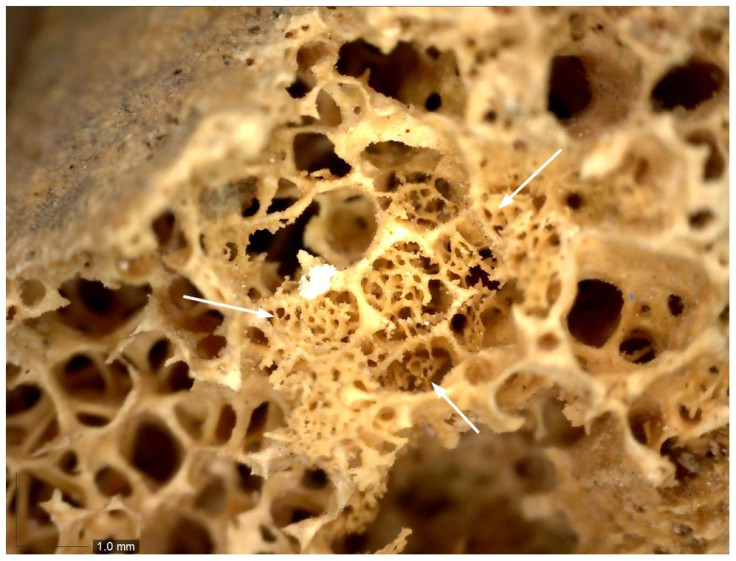3,000-Year-Old Cancer-Ridden Skeleton Offers Clues To Evolution Of Disease In Past Societies

Cancer is the second most common cause of death in the U.S., accounting for nearly one of every four deaths. Scores of research have looked into the lifestyles that cause it, how it spreads, and how to treat it, but many if not all of the studies conducted on it have only looked at it within the context of the modern world. Now, archaeologists have discovered what’s being called the oldest evidence of metastatic carcinoma, in the skeleton of a man from Ancient Nubia who lived sometime around 1200 B.C.
Their findings, published in the journal PLoS One, are of “critical important in learning about the underlying causes of cancer in ancient populations, before the onset of modern lifestyles,” Michaela Binder, a PhD student at Durham University, England, told the BBC. Binder found the skeleton in the Amara West excavation site of northern Sudan. “I was surprised to see such a cancer in an individual from ancient Egyptian times. We still don’t know a lot about cancer. Only a very few examples have been found of the disease in the distant past.”
The study notes that cancer is largely a modern disease, as its prevalence began to rise after industrialization, when living conditions improved, and infectious diseases abated. Because of this, the causes of cancer have been attributed to environmental and lifestyle factors, such as smoking, diet, a lack of physical activity, pollution, and some consumer products.
In addition to these factors, researchers had long believed that cancer needed time to develop, as growing into old age — it was believed that many people only lived up to 50 years old — allows more room for error in the body’s replicating cells. However, based on these findings and some previous ones, old age in “past populations may in fact be a misconception created by inadequate methods for accurately estimating adult age-at-death in human remains,” the researchers wrote. Understanding the evolution of cancer back then may therefore open up new avenues for research into not only cancer, but into understanding past populations as well.
Binder and her team of archaeologists discovered the skeleton covered in cancerous holes. A preliminary analysis showed that the man had suffered from cancer. “If they analyze the DNA from the skeleton, it might tell us about the gene mutations that made this person susceptible to this type of cancer,” Dr. Kat Arney, of Cancer Research UK, told the BBC. “That could shed light on the evolution of the disease, along with the evolution of humankind.”
Source: Binder M, Roberts C, Spencer N, et al. On the Antiquity of Cancer: Evidence for Metastatic Carcinoma in a Young Man from Ancient Nubia (c. 1200BC). PloS One. 2014. Cancer is the second most common cause of death in the U.S., accounting for nearly one of every four deaths. Scores of research have looked into the lifestyles that cause it, how it spreads, and how to treat it, but many if not all of the studies conducted on it have only looked at it within the context of the modern world. Now, archaeologists have discovered what’s being called the oldest evidence of metastatic carcinoma, in the skeleton of a man from Ancient Nubia who lived sometime around 1200 B.C.
Their findings, published in the journal PLoS One, are of “critical important in learning about the underlying causes of cancer in ancient populations, before the onset of modern lifestyles,” Michaela Binder, a PhD student at Durham University, England, told the BBC. Binder found the skeleton in the Amara West excavation site of northern Sudan. “I was surprised to see such a cancer in an individual from ancient Egyptian times. We still don’t know a lot about cancer. Only a very few examples have been found of the disease in the distant past.”
The study notes that cancer is largely a modern disease, as its prevalence began to rise after industrialization, when living conditions improved, and infectious diseases abated. Because of this, the causes of cancer have been attributed to environmental and lifestyle factors, such as smoking, diet, a lack of physical activity, pollution, and some consumer products.
In addition to these factors, researchers had long believed that cancer needed time to develop, as growing into old age — it was believed that many people only lived up to 50 years old — allows more room for error in the body’s replicating cells. However, based on these findings and some previous ones, old age in “past populations may in fact be a misconception created by inadequate methods for accurately estimating adult age-at-death in human remains,” the researchers wrote. Understanding the evolution of cancer back then may therefore open up new avenues for research into not only cancer, but into understanding past populations as well.

Binder and her team of archaeologists discovered the skeleton covered in cancerous holes. A preliminary analysis showed that the man had suffered from cancer. “If they analyze the DNA from the skeleton, it might tell us about the gene mutations that made this person susceptible to this type of cancer,” Dr. Kat Arney, of Cancer Research UK, told the BBC. “That could shed light on the evolution of the disease, along with the evolution of humankind.”
Source: Binder M, Roberts C, Spencer N, et al. On the Antiquity of Cancer: Evidence for Metastatic Carcinoma in a Young Man from Ancient Nubia (c. 1200BC). PloS One. 2014.



























